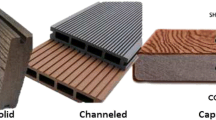Abstract
Paraffin has been used as surface protection of wood throughout the ages but its use for impregnation to improve wood resistance to biodegradation is recent. This study determined the main improvements on wood properties with paraffin impregnation. Healthy Pinus pinaster Ait. wood was impregnated with paraffin at different levels using a hot–cold process. Weight gain, equilibrium moisture content and dimensional stability (ASE) at 35 and 65 % relative humidity, termite durability against Reticulitermes grassei (Clément), bending strength, bending stiffness (MOE) and Janka hardness were determined. Density increased from 0.57 to 0.99, ASE ranged between 38–96 % and 16–71 % for 35 and 65 % relative humidity, respectively. Equilibrium moisture content decreased from 9.9 and 12.0 % to 0.8 and 3.6 % for 35 and 65 % relative humidity. Termite durability improved from level 4 to level 3 of attack, and higher termite mortality was found in treated wood (52 % against 17 %). Bending strength (MOR) increased with paraffin weight gain, reaching a 39 % increase. MOE also increased by about 13 % for wood with a weight gain around 80 %. Janka hardness increased significantly reaching about 40 % for wood with 80 % weight gain. Paraffin impregnated wood has improved properties with regard to equilibrium moisture content, dimensional stability and density, bending strength and Janka hardness, and resistance against termites.




Similar content being viewed by others
References
Belville P (1982) Modeling of the kinetics of pyrolysis of wood particles of large size and the material balance of gasification in pure oxygen (in French). Thesis University of Compiègne, France
EN 117 (2005) Wood preservatives—determination of toxic values against Reticulitermes species (European termites) (Laboratory method). European Committee for Standardization, Brussels
Esteves BM, Pereira H (2009) Wood modification by heat treatment: a review. BioResources 4:340–404
Esteves B, Domingos I, Pereira H (2007a) Improvement of technological quality of eucalypt wood by heat treatment in air at 170–200 degrees C. Prod J 57:47–52
Esteves B, Marques AV, Domingos I, Pereira H (2007b) Influence of steam heating on the properties of pine (Pinus pinaster) and eucalypt (Eucalyptus globulus) wood. Wood Sci Technol 41:193–207
Esteves B, Domingos I, Pereira H (2008) Pine wood modification by heat treatment in air. BioResources 3:142–154
Esteves B, Nunes L, Pereira H (2011) Properties of furfurylated wood (Pinus pinaster). Eur J Wood Wood Prod 69(4):521–525
Hill C (2006) Wood modification: chemical, thermal and other processes. Wiley, Chichester
ISO 3350 (1975) Wood—determination of static hardness
Kim G, Yun K, Kim J (1998) Effect of heat treatment on the decay resistance and the bending properties of radiata pine sapwood. Material und Organismen 32(2):101–108
Korkut S, Akgü M, Dündar T (2008) The effects of heat treatment on some technological properties of Scots pine (Pinus sylvestris L.) wood. Bioresour Technol 99:1861–1868
Kurt R, Krause A, Militz H, Mai C (2008) Hydroxymethylated resorcinol (HMR) priming agent for improved bondability of wax-treated wood. Holz Roh-Werkst 66:333–338
Lesar B, Humar M (2010) Use of wax emulsions for improvement of wood durability and sorption properties. Eur J Wood Wood Prod 69:231–238
Lesar B, Kralj P, Humar M (2009) Montan wax improves performance of boron-based wood preservatives. Int Biodeterior Biodegrad 63:306–310
Lesar B, Pavlič M, Petrič M, Skapin AS, Humar M (2011) Wax treatment of wood slows photodegradation. Polym Degrad Stab 96:1271–1278
Órfão J, Antunes F, Figueiredo J (1999) Pyrolysis kinetics of lignocellulosic materials—three independent reactions model. Fuel 78:349–358
Rowell RM (2006) Chemical modification of wood: a short review. Wood Mater Sci Eng 1:29–33
Scholz G, Militz H, Gascón-Garrido P, Ibiza-Palacios MS, Oliver-Villanueva JV, Peters BC, Fitzgerald CJ (2010) Improved termite resistance of wood by wax impregnation. Int Biodeterior Biodegrad 64:688–693
Scholz G, Adamopoulos S, Militz H (2011) Migration of blue stain fungi within wax impregnated wood. IAWA J Int Assoc Wood Anat 32:88
Stamm A (1956) Thermal degradation of wood and cellulose. Ind Eng Chem 48:413–417
Tjeerdsma B, Boonstra M, Pizzi A, Tekely P, Militz H (1998) Characterisation of thermally modified wood: molecular reasons for wood performance improvement. Holz Roh-Werkst 56:149–153
Acknowledgments
The authors would like to thank the Portuguese Foundation for Science and Technology (FCT) through projects PEst-OE/CED/UI4016/2014 and Pest-OE-AGR-UI0239-2013, and the Center for Studies in Education, Technologies and Health (CI&DETS).
Author information
Authors and Affiliations
Corresponding author
Rights and permissions
About this article
Cite this article
Esteves, B., Nunes, L., Domingos, I. et al. Improvement of termite resistance, dimensional stability and mechanical properties of pine wood by paraffin impregnation. Eur. J. Wood Prod. 72, 609–615 (2014). https://doi.org/10.1007/s00107-014-0823-7
Received:
Published:
Issue Date:
DOI: https://doi.org/10.1007/s00107-014-0823-7




